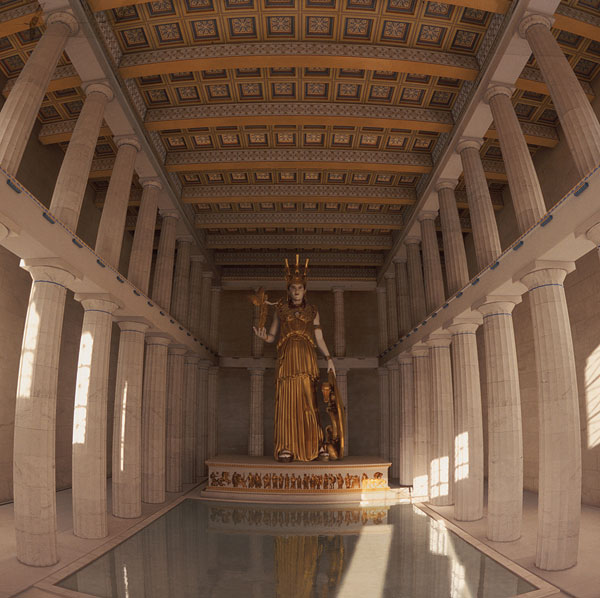THE SCULPTURES OF THE PARTHENON
By: Mason Neal, Sharon Houstoun and Kendle Windham
This web page focuses on the sculptures that are inside of the Parthenon. The Parthenon is located on the Athenian Acropolis, a hill in the center of the ancient city of Athens. It is dedicated to the Goddess Athena who is the patron God of Athens. The sculptures, both inside and on the outside of the Parthenon, mainly depict that goddess in different situations such as her birth. The Parthenon was built by the Athenian Empire that was in power from the mid 5th century BC until 404 BC.
Building of the Parthenon (sculptures)

- The building types changed over the years until they developed into the type showed in the Parthenon
- Parthenon style shows the advancement in their art since the Olympia stuff
- Shows less than ideal features
- Variety of techniques that showed the statues were made by different artists
o The relaxed figures and seated poses show more confidence than the Olympian sculptures
o The artists do not portray emotion because the figures depict the ideal mortal who is near-divine and above human emotions (Boardman 37)
- Phidias, a famous Greek sculptor, designed sculptural decorations
- 432 B.C.- sculptures finished
- Some were reliefs some were in the rounds (three dimensional)
- The Statues are made of marble (Stockstad 105)
What the Parthenon looks like today
Photo Credit: Dillon Houstoun. Taken in 1999
The Parthenon- Athens, Greece circa 432 BCE
Sculptures
- They all have something to do with Athena
- The sculptures on the east pediment illustrate the birth of Athena
- One showed Zeus seated on his throne with Athena next to him and many other gods depicted
- West pediment contains sculpture showing Athena’s victory over Poseidon for Athens (Stockstad 106)
- Below the peristyle the walls of the temple was a 3.25 foot deep frieze 39 ft above the floor
o Depicted 350 people and 125 horses participating in the Great Panathenaea -procession in which the youth of the city accompanied a wheeled ship carrying a new robe for an ancient wooden statue of Athena.
The Statue of the Athena
- Statue of Athena- 40 ft high, made of gold and ivory and designed by Phidias, lots of detail
- Tunic made of gold plates, and skin of ivory
- Pausanias- said that there was an image of a sphinx was on Athena’s helmet
- In one hand was a 6ft statue of victory, spear in the other, and shield at her feet
Pediments in the Parthenon

- The pediment is full of sculptures different sculpture (talked about above)
- It is over 90 feet long
- A pediment is a classical architectural element that is a block of stone supported by columns
Metopes in the Parthenon
- 92 metopes with 350 figure
- Ametope is an architectural element that fills the space between triglyphs in a Doric Frieze
- Southern metope depicts scenes from Centauromachy (Pasquier 67)
- Lapiths are ancient people from Thessaly who had a great battle with the Centaurs which was the Centauromachy
- Metope carved above the columns showing many different stories such as the Trojan War
|
The Statue of Athena at Parthenon Athens, Greece Circa 432 B.C.
http://www.socialtravellersite.com/the-most-photographed-places-in-the-world
|

Sculptures from the pediment at the Parthenon
http://image59.webshots.com/159/0/56/5/2443056050089165801csPgVA_ph.jpg

|
A very abstract frieze on the west side of the Parthenon depicting horses and
horsemen
http://idliketocallyourattentionto.blogspot.com/2007/05/
parthenon-sculptures-frieze.html
|
Bibliography
Boardman, John. Greek Art- Fourth Edition. New York, New York: Thames and Hudson, 1996.
Boardman, John, and David Finn. “Parthenon.” World History: Ancient and Medieval Eras. 2008. ABC-CLIO. 4 Dec. 2008 <http://www.ancienthistory.abc-clio.com/>.
Pasquier, Alain. The Greek World. New York, New York: Rizzoli, 1996.
Stockstad, Marilyn. Art: A Brief History- Third Edition. Upper Saddle River, New Jersey: Pearson Education, Inc., 2007.
Comments (4)
Cris Salazar said
at 2:02 pm on Dec 5, 2008
hey Mason
Kendle W said
at 2:12 pm on Dec 8, 2008
don't have personal matters on our wiki
Mason Neal said
at 9:55 pm on Dec 8, 2008
dont be unkind on our wiki
Anonymous said
at 12:37 am on Dec 16, 2008
oh my goodness its a picture of the Houstoun family. this is automatically my favorite wiki. ever.
You don't have permission to comment on this page.